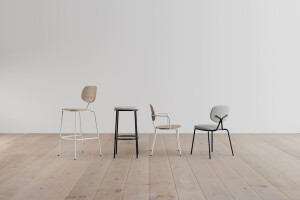At first sight, Cellular Loop might be mistaken for an ordinary chair – if it wasn’t for its eye-catching cell structure and its seamless, endless ribbon shape, similar to a moebius strip. The chair is extremely lightweight, but also possesses the stiffness and stability as well as the elasticity one would expect from a cantilever chair. In order to achieve these characteristics, concepts from the natural world have been transferred to its construction and production method.
Cellular Loop is the first result of research project Bionic Manufacturing, conducted by Folkwang University of Arts in Essen in collaboration with Fraunhofer UMSICHT and other partners on commission of the German Federal Ministry of Education and Research. Cellular Loop is also the first cantilever chair to be produced by Rapid Prototyping.
The aim of the research project was to develop a production method for components, inspired by biological construction principles and based on selective laser sintering. A cantilever chair was chosen as demonstration object, because chairs are considered the supreme discipline of design, but also because a cantilever chair is the perfect object for testing issues like dynamic strain, basic stiffness and minimal use of material. In addition, there’s much more interaction between a cantilever chair and its user than with other seating furniture. Transferring models from nature to the production technique resulted in a light, yet stable chair with an internal structure which is ideally adapted to various forms of local strain.
In contrast to most technical materials, natural materials aren’t homogeneous, but have a complex hierarchical inner structure, which lends them extraordinary characteristics. The examples referred to are the micro-supports in the skull bones of Tawny owls and the wing bones of colibris, the strings inside banana leaf stems and the wound healing methods of trees. Rapid Prototyping made it possible to produce the chair in the complex shape of an endless, self-penetrating ribbon.
Examples from Nature
Bones Fraunhofer IWM has developed a tool for interpreting, evaluating and optimizing lightweight constructions, which fills the exterior shape of an object with a cell structure based on a trabecula bone cell. The structure of the Cellular Loop chair was created with the help of this tool.
Bones are a prime example of lightweight construction systems. They carry the entire weight of the body, while being as light as possible, because additional weight would cost more energy when moving. Among the most efficient are bird bones, which can deal with very high dynamic strain while being extremely lightweight.
The astonishing capacities of bones result from their tissue structure: They’re not solid, but contain a network of small rods (trabecula), forming the spongy interior of the bone. Trabecula are arranged at random and always create a diagonal connection between two points of the inner bone shell. The architecture of the tissue depends on whether the respective bone section is mainly exposed to pressure, torsion or bending forces. For designers, parametrically adaptable trabecula structures offer the possibility to detach the mechanical characteristics (e.g. stiffness) from the exterior shape of an object.
Banana leaf stem Biological structures are optimized regarding stiffness and material use. In many cases, components within the structure act as tension rods. The advantage of tension rods over pressure struts is that bending or denting doesn’t harm their stability. The profile section of a banana leaf stem served as a model for the functional combination of seating comfort and strain- optimized construction in the Cellular Loop chair. Banana leaf stems have a tension rod strucutre with threads which are arranged at a right angle to the surface, thus absorbing tension forces when the leaf is bent. The interior trabercula structure of the chair works according to the same principle.
Wound healing in trees Where the back of the cantilever chair penetrates the seat, the wound healing method of trees was used as a model for the trabecula structure of the chair. A knothole has the same effect as a notch in the tree, because it diverts the flow of forces. Therefore the tree builds up additional material around the hole, and initially round holes turn lens-shaped. The healing process reduces the notch stress and re-establishes the homogenous distribution of stress.
This adaptive growth as a response to high strain served as a model for the transition from narrow to wide to narrow trabecula structures at the intersection of back rest and seat of the Cellular Loop chair.
Aesthetic inspiration A source of inspiration for the Cellular Loop chair were glass sponges. These deep sea creatures have an elegant skeleton structure, consisting of thousands of silicate needles, which form a very stable, cage-like sponge skeleton with periodical, orthogonal cells. Its remarkable spatial structure was an inspiration for the design of the trabecula structure of the chair.
Construction The chair’s weekest points turned out to be at the backrest (red colour), so this is where the software -developed by Fraunhofer- located the thickest trabecular structure.













